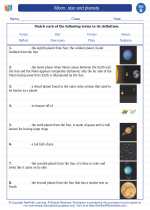Moon, Stars, and Planets
Let's explore the wonders of the universe! The moon, stars, and planets are all part of our solar system and beyond. Understanding these celestial bodies can be an exciting journey into the mysteries of space.
The Moon
The moon is Earth's natural satellite. It orbits around the Earth, and its gravitational pull causes the ocean tides. The moon has different phases, including full moon, new moon, crescent, and gibbous. It has a rocky surface with plains, mountains, and craters. The moon's gravity is about one-sixth that of Earth's, which is why astronauts can bounce around on its surface.
Stars
Stars are massive, luminous spheres of plasma held together by gravity. They emit light and heat through nuclear reactions in their cores. The sun is the closest star to Earth, and it provides the energy that sustains life on our planet. Stars come in different colors, sizes, and temperatures. They are grouped together in galaxies, and our sun is part of the Milky Way galaxy.
Planets
Planets are large, spherical objects that orbit stars. In our solar system, there are eight planets: Mercury, Venus, Earth, Mars, Jupiter, Saturn, Uranus, and Neptune. These planets vary in size, composition, and atmospheric conditions. Some have moons, rings, and extreme weather patterns. The study of planets is called planetary science.
Study Guide
- What causes the ocean tides on Earth?
- How does the moon's gravity compare to that of Earth's?
- What are some of the different phases of the moon?
- What is the sun, and how does it support life on Earth?
- How are stars grouped in space?
- Name the eight planets in our solar system.
- What is planetary science?
Now that you've learned about the moon, stars, and planets, you can continue your exploration of the universe with curiosity and wonder!
.◂Science Worksheets and Study Guides Second Grade. Moon, star and planets
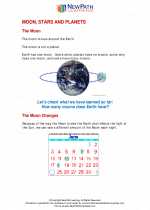
 Activity Lesson
Activity Lesson
 Worksheet/Answer key
Worksheet/Answer key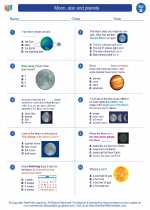
 Worksheet/Answer key
Worksheet/Answer key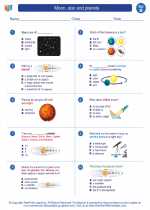
 Worksheet/Answer key
Worksheet/Answer key
 Vocabulary/Answer key
Vocabulary/Answer key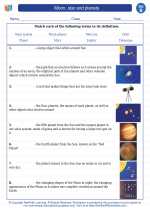
 Vocabulary/Answer key
Vocabulary/Answer key